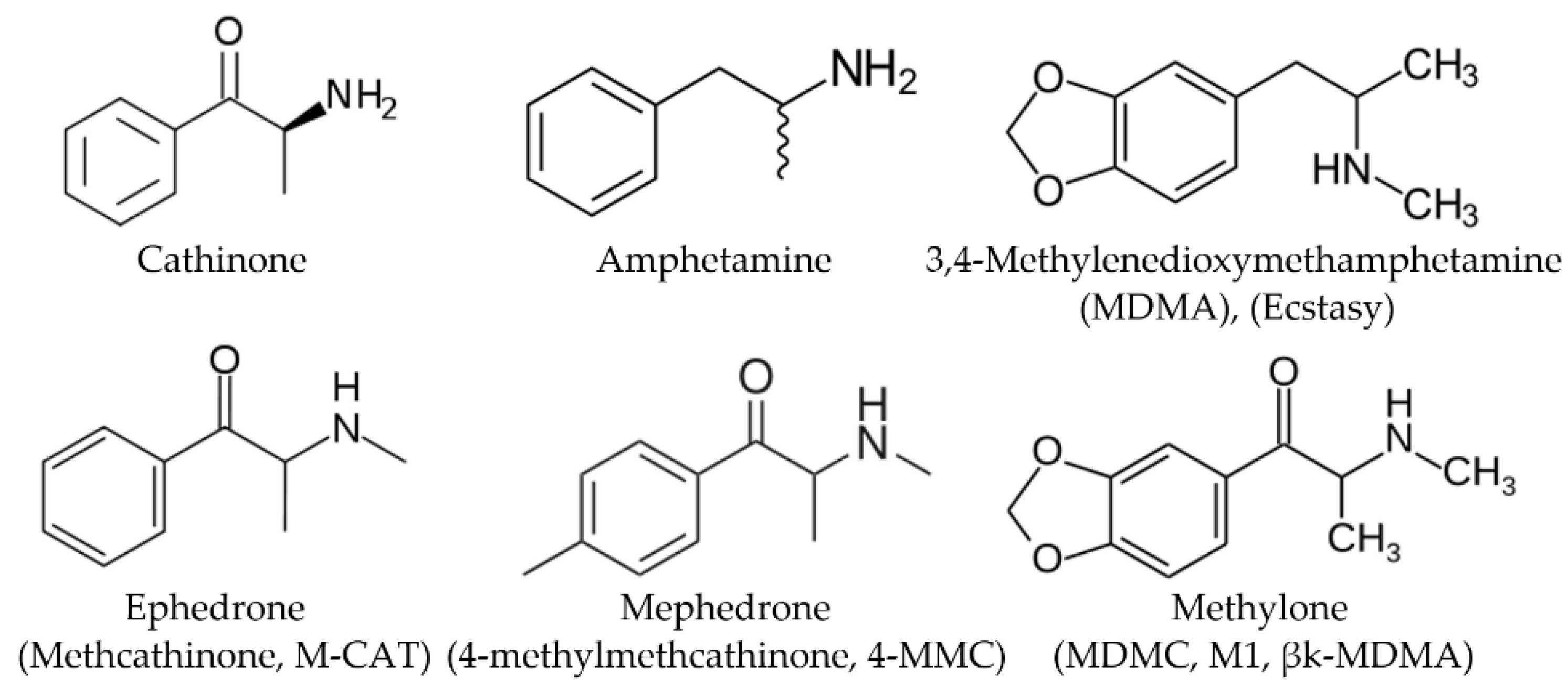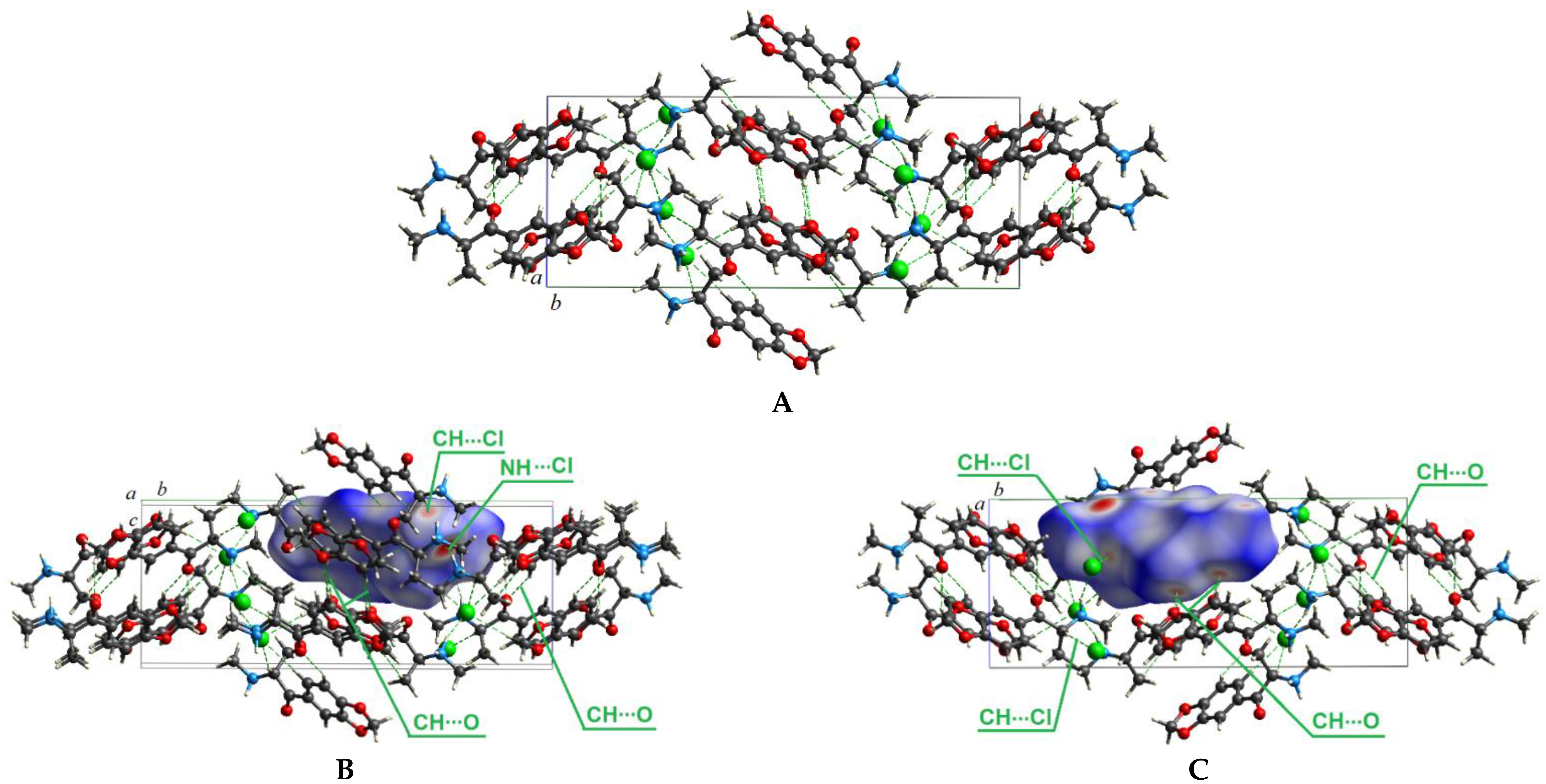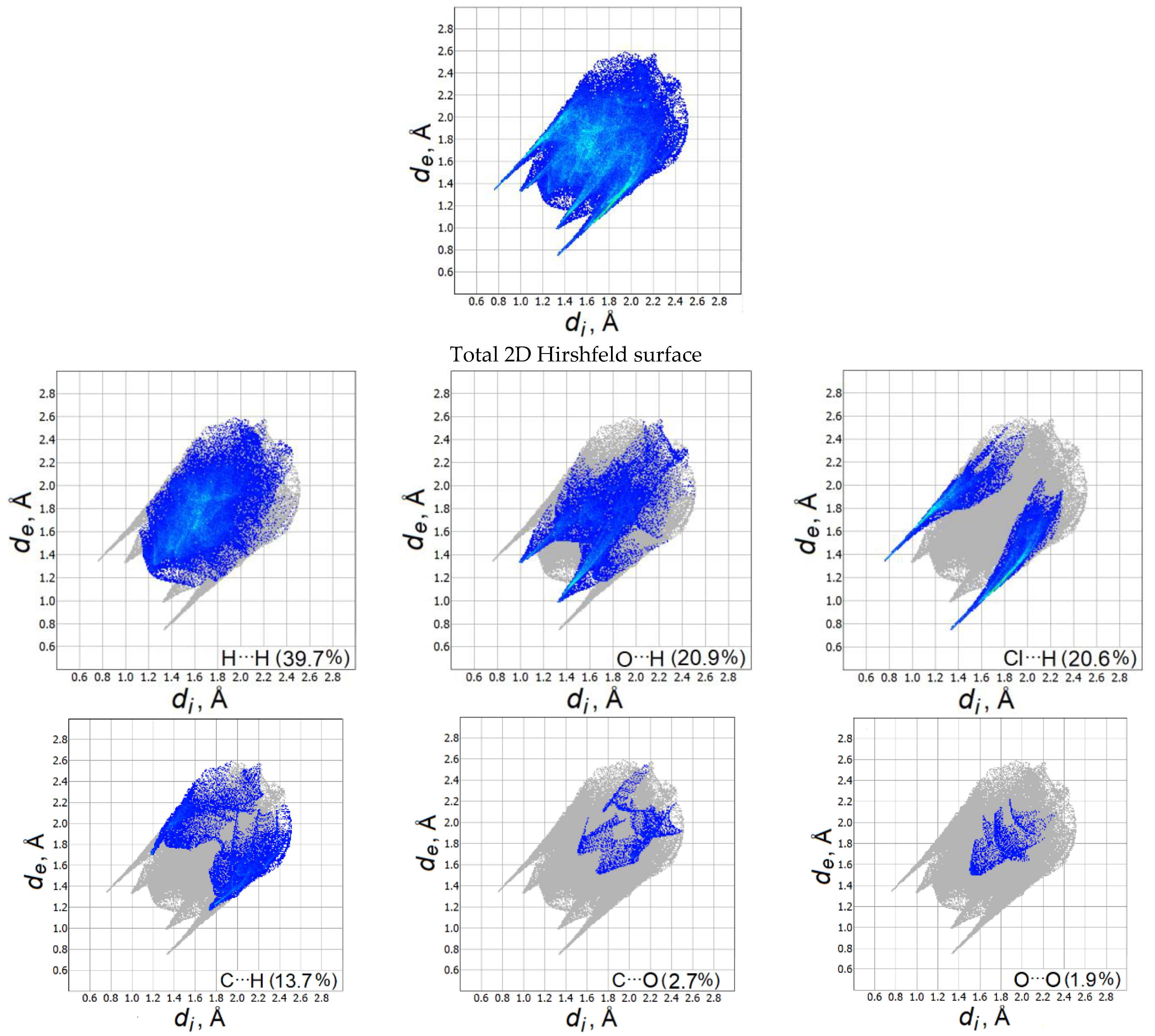Hirshfeld and AIM Analysis of the Methylone Hydrochloride Crystal Structure and Its Impact on the IR Spectrum Combined with DFT Study
Abstract
1. Introduction
2. Computational Details
3. Results and Discussion
3.1. Hirshfeld Surface Analysis
3.2. Structural Features in the Dimers of Methylone Hydrochloride, DFT Results
3.3. Bader’s QTAIM Analysis
3.4. IR Spectra of the Methylone Hydrochloride Dimers
4. Conclusions
Supplementary Materials
Author Contributions
Funding
Data Availability Statement
Acknowledgments
Conflicts of Interest
References
- Cottencin, O.; Rolland, B.; Karila, L. New designer drugs (synthetic cannabinoids and synthetic cathinones): Review of literature. Curr. Pharm. Des. 2014, 20, 4106–4111. [Google Scholar] [CrossRef]
- Hyde, J.F.; Browning, E.; Adams, R. Synthetic Homologs of d,l-Ephedrine. J. Am. Chem. Soc. 1928, 50, 2287–2292. [Google Scholar] [CrossRef]
- L’italien, Y.J.; Park, H.; Rebstock, M.C. Ethylaminopropiophenone Compounds. U.S. Patent No. 2802865, 1954. [Google Scholar]
- Sanchez, S. Sur un homologue de l’ephedrine. Bull. Soc. Chim. Fr. 1929, 45, 284–286. [Google Scholar]
- Green, A.R.; King, M.V.; Shortall, S.E.; Fone, K.C.F. The preclinical pharmacology of mephedrone; not just MDMA by another name. Br. J. Pharmacol. 2014, 171, 2251–2268. [Google Scholar] [CrossRef] [PubMed]
- Peyton, J.; Shulgin, A.T. Novel n-Substituted-2-Amino-3′,4′-Methylene-Dioxypropiophenones. WIPO Patent WO1996039133A1, 12 December 1996. [Google Scholar]
- Gregg, R.A.; Rawls, S.M. Behavioral pharmacology of designer cathinones: A review of the preclinical literature. Life Sci. 2014, 97, 27–30. [Google Scholar] [CrossRef] [PubMed]
- Simmler, L.D.; Buser, T.A.; Donzelli, M.; Schramm, Y.; Dieu, L.-H.; Huwyler, J.; Chaboz, S.; Hoener, M.C.; Liechti, M.E. Pharmacological characterization of designer cathinones in vitro. Br. J. Pharmacol. 2013, 168, 458–470. [Google Scholar] [CrossRef] [PubMed]
- Karila, L.; Megarbane, B.; Cottencin, O.; Lejoyeux, M. Synthetic cathinones: A new public health problem. Curr. Neuropharmacol. 2015, 13, 12–20. [Google Scholar] [CrossRef]
- Karila, L.; Billieux, J.; Benyamina, A.; Lançon, C.; Cottencin, O. The effects and risks associated to mephedrone and methylone in humans: A review of the preliminary evidences. Brain Res. Bull. 2016, 126, 61–67. [Google Scholar] [CrossRef]
- Watterson, L.R.; Hood, L.; Sewalia, K.; Tomek, S.E.; Yahn, S.; Johnson, C.T.; Wegner, S.; Blough, B.E.; Marusich, J.A.; Olive, M.F. The Reinforcing and Rewarding Effects of Methylone, a Synthetic Cathinone Commonly Found in “Bath Salts”. J. Addict. Res. Ther. 2012, S9, 002. [Google Scholar] [CrossRef]
- Martínez-Clemente, J.; Escubedo, E.; Pubill, D.; Camarasa, J. Interaction of mephedrone with dopamine and serotonin targets in rats. Eur. Neuropsychopharmacol. 2012, 22, 231–236. [Google Scholar] [CrossRef] [PubMed]
- Prosser, J.M.; Nelson, L.S. The toxicology of bath salts: A review of synthetic cathinones. J. Med. Toxicol. 2012, 8, 33–42. [Google Scholar] [CrossRef]
- Winstock, A.; Mitcheson, L.; Ramsey, J.; Davies, S.; Puchnarewicz, M.; Marsden, J. Mephedrone: Use, subjective effects and health risks. Addiction 2011, 106, 1991–1996. [Google Scholar] [CrossRef] [PubMed]
- European Monitoring Centre for Drugs Drug Addiction (EMCDDA), Europol–EMCDDA Joint Report on a New Psychoactive Substance: 4-methylmethcathinone (Mephedrone). EMCDDA: Lisbon, Portugal, 2010. Available online: https://www.emcdda.europa.eu/publications/joint-reports/mephedrone_en (accessed on 1 March 2010).
- European Monitoring Centre for Drugs and Drug Addiction (EMCDDA). European Drug Report 2021: Trends and Developments. Publications Office of the European Union. 2021. Available online: https://www.emcdda.europa.eu/publications/edr/trends-developments/2021_en (accessed on 1 June 2021).
- Bolcato, V.; Carelli, C.; Radogna, A.; Freni, F.; Moretti, M.; Morini, L. New Synthetic Cathinones and Phenylethylamine Derivatives Analysis in Hair: A Review. Molecules 2021, 26, 6143. [Google Scholar] [CrossRef]
- Martin, M.; Muller, J.F.; Turner, K.; Duez, M.; Cirimele, V. Evidence of mephedrone chronic abuse through hair analysis using GC/MS. Forensic Sci. Int. 2012, 218, 44–48. [Google Scholar] [CrossRef] [PubMed]
- Strano-Rossi, S.; Anzillotti, L.; Castrignano, E. Francesco Saverio Romolo; Marcello Chiarotti Ultra high performance liquid chromatography–electrospray ionization–tandem mass spectrometry screening method for 150 direct analysis of designer drugs, “spice” and stimulants in oral fluid. J. Chromatogr. A 2012, 1258, 37–42. [Google Scholar] [CrossRef]
- Loganathan, D.; Yi, R.; Patel, B.; Zhang, J.; Kong, N. A sensitive HPLC-MS/MS method for the detection, resolution and quantitation of cathinone enantiomers in horse blood plasma and urine. Anal. Bioanal. Chem. 2021, 413, 2147–2161. [Google Scholar] [CrossRef]
- Beyer, J.; Peters, F.T.; Kraemer, T.; Maurer, H.H. Detection and validated quantification of nine herbal phenalkylamines and methcathinone in human blood plasma by LC-MS/MS with electrospray ionization. J. Mass Spectrom. 2007, 42, 150. [Google Scholar] [CrossRef]
- Ammann, J.; McLaren, J.M.; Gerostamoulos, D.; Beyer, J. Detection and Quantification of New Designer Drugs in Human Blood: Part 2–Designer Cathinones. J. Anal. Toxicol. 2012, 36, 381. [Google Scholar] [CrossRef]
- Meyer, M.R.; Wilhelm, J.; Peters, F.T.; Maurer, H.H. Beta-keto amphetamines: Studies on the metabolism of the designer drug mephedrone and toxicological detection of mephedrone, butylone, and methylone in urine using gas chromatographymass spectrometry. Anal. Bioanal. Chem. 2010, 397, 1225–1233. [Google Scholar] [CrossRef]
- Kamata, H.T.; Shima, N.; Zaitsu, K.; Kamata, T.; Miki, A.; Nishikawa, M.; Katagi, M.; Tsuchihashi, H. Metabolism of the recently encountered designer drug, methylone, in humans and rats. Xenobiotica Fate Foreign Compd. Biol. Syst. 2006, 36, 709–723. [Google Scholar] [CrossRef] [PubMed]
- Kamata, H.T.; Shima, N.; Zaitsu, K.; Kamata, T.; Nishikawa, M.; Katagi, M.; Miki, A.; Tsuchihashi, H. Simultaneous Analysis of New Designer Drug, Methylone, and Its Metabolites in Urine by Gas Chromatography-Mass Spectrometry and Liquid Chromatography-Electrospray Ionization Mass Spectrometry. Jpn. J. Forensic Sci. Technol. 2007, 12, 97. [Google Scholar] [CrossRef]
- Scientific Working Group for the Analysis of Seized Drugs (SWGDRUG) Website. Available online: http://www.swgdrug.org/ (accessed on 18 January 2023).
- Cayman Chemical. Available online: https://www.caymanchem.com/ (accessed on 18 January 2023).
- Minaeva, V.A.; Karaush-Karmazin, N.N.; Panchenko, A.A.; Heleveria, D.N.; Minaev, B.F. Hirshfeld surfaces analysis and DFT study of the structure and IR spectrum of N-ethyl-2-amino-1-(4-chlorophenyl)propan-1-one (4-CEC) hydrochloride. Comput. Theor. Chem. 2021, 1205, 113455. [Google Scholar] [CrossRef]
- Minaeva, V.; Minaev, B.; Panchenko, A.; Pasychnik, V. Computational study of IR, Raman and NMR spectra of 4-methylmethcathinone drug. J. Mol. Model. 2021, 27, 3. [Google Scholar] [CrossRef]
- Minaeva, V.; Panchenko, A.; Karaush-Karmazin, N.; Nycz, J.; Minaev, B. Manifestation of Intermolecular Interactions in the IR Spectra of 2- and 4-Methylmethcathinones Hydrochlorides: DFT Study and Hirshfeld Surfaces Analysis. Biointerface Res. Appl. Chem. 2023, 13, 202. [Google Scholar] [CrossRef]
- McKinnon, J.J.; Spackman, M.A.; Mitchell, A.S. Novel tools for visualizing and exploring intermolecular interactions in molecular crystals. Acta Crystallogr. Sect. B Struct. Sci. 2004, 60, 627–668. [Google Scholar] [CrossRef]
- Spackman, M.A.; Jayatilakaa, D. Hirshfeld surface analysis. Cryst. Eng. Comm. 2009, 11, 19–32. [Google Scholar] [CrossRef]
- Spackman, P.R.; Turner, M.J.; McKinnon, J.J.; Wolff, S.K.; Grimwood, D.J.; Jayatilaka, D.; Spackman, M.A. Crystal Explorer: A program for Hirshfeld surface analysis, visualization and quantitative analysis of molecular crystals. J. Appl. Cryst. 2021, 54, 1006–1011. [Google Scholar] [CrossRef]
- Bader, R.F.W. Atoms in Molecules. In A Quantum Theory; Clarendon Press: Oxford, UK, 1990; ISBN 9780198558651. [Google Scholar]
- Becke, A.D. Density-functional thermochemistry. III. The role of exact exchange. J. Chem. Phys. 1993, 98, 5648–5652. [Google Scholar] [CrossRef]
- Mardirossian, N.; Head-Gordon, M. Thirty years of density functional theory in computational chemistry: An overview and extensive assessment of 200 density functional. Mol. Phys. 2017, 115, 2315–2372. [Google Scholar] [CrossRef]
- Lee, C.; Yang, W.; Parr, R.G. Development of the Colle-Salvetti correlation-energy formula into a functional of the electron density. Phys. Rev. B 1988, 37, 785–789. [Google Scholar] [CrossRef] [PubMed]
- Francl, M.M.; Petro, W.J.; Hehre, W.J.; Binkley, J.S.; Gordon, M.S.; DeFrees, D.J.; Pople, J.A. Self-consistent molecular orbital methods. XXIII. A polarization-type basis set for second-row elements. J. Chem. Phys. 1982, 77, 3654–3666. [Google Scholar] [CrossRef]
- Grimme, S.; Antony, J.; Ehrlich, S.; Krieg, H. A consistent and accurate ab initio parametrization of density functional dispersion correction (DFT-D) for the 94 elements H-Pu. J. Chem. Phys. 2010, 132, 154104. [Google Scholar] [CrossRef] [PubMed]
- Frisch, M.J.; Trucks, G.W.; Schlegel, H.B.; Scuseria, G.E.; Robb, M.A.; Cheeseman, J.R.; Scalmani, G.; Barone, V.; Petersson, G.A.; Nakatsuji, H.; et al. Gaussian 16, Revision A.03; Gaussian, Inc.: Wallingford, CT, UK, 2016. [Google Scholar]
- Scott, A.P.; Radom, L. Harmonic Vibrational Frequencies: An Evaluation of Hartree−Fock, Møller−Plesset, Quadratic Configuration Interaction, Density Functional Theory, and Semiempirical Scale Factors. J. Phys. Chem. 1996, 100, 16502–16513. [Google Scholar] [CrossRef]
- Gorelsky, S.I. SWizard Program, University of Ottawa, Ottawa, Canada 2013. Available online: http://www.sg-chem.net (accessed on 18 January 2023).
- Keith, T.A. AIMAll (Version 10.07.25); TK Gristmill Software: Overland ParkKS, KS, USA, 2010; Available online: www.aim.tkgristmill.com (accessed on 18 January 2023).
- Espinosa, E.; Molins, E.; Lecomte, C. Hydrogen bond strengths revealed by topological analyses of experimentally observed electron densities. Chem. Phys. Lett. 1998, 285, 170–173. [Google Scholar] [CrossRef]
- Espinosa, E.; Alkorta, I.; Rozas, I.; Elguero, J.; Molins, E. About the evaluation of the local kinetic, potential and total energy densities in closed-shell interactions. Chem. Phys. Lett. 2001, 336, 457–461. [Google Scholar] [CrossRef]
- Nycz, J.E.; Malecki, G.; Zawiazalec, M.; Pazdziorek, T. X-ray structures and computational studies of several cathinones. J. Mol. Struct. 2011, 1002, 10–18. [Google Scholar] [CrossRef]
- Huber, K.P.; Herzberg, G. Molecular Spectra and Molecular Structure. IV. Constants of Diatomic Molecules; Van Nostrand Reinhold Company: New York, NY, USA, 1979. [Google Scholar]
- Monograph—SWGDRUG.org. Available online: https://www.swgdrug.org/monographs.htm (accessed on 18 January 2023).
- SpectraBase. Available online: https://spectrabase.com/ (accessed on 25 January 2023).
- Socrates, G. Infrared Raman Characteristic Group Frequencies–Tables and Charts, 3rd ed.; John Wiley & Son: Hoboken, NJ, USA, 2001. [Google Scholar] [CrossRef]






| Structural Parameters | Dimer 1 | Dimer 2 | ||||||
|---|---|---|---|---|---|---|---|---|
| Molecule 1 | Molecule 2 | Molecule 1 | Molecule 2 | |||||
| Theor. | Exp. [46] | Theor. | Exp. [46] | Theor. | Exp. [46] | Theor. | Exp. [46] | |
| NH–Cl | 1.890 | 2.216 | 1.992 | 2.197 | 2.038 | 2.197 | 2.051 | 2.197 |
| O⋯Cl | 3.843 | 3.888 | 3.279 | 3.678 | 3.790 | 3.678 | 3.790 | 3.678 |
| O⋯HN | 2.443 | 2.513 | 2.415 | 2.603 | 2.301 | 2.603 | 2.396 | 2.603 |
| O⋯H2C | 2.077 | 1.980 | 2.077 | 1.980 | 2.078 | 1.980 | 2.078 | 1.980 |
| Cl⋯CH | 2.942 | 3.994 | 3.543 | 3.781 | 3.211 | 3.781 | 3.343 | 3.781 |
| Cl⋯H(CH3) | 2.850 | 3.584 | 3.755 | 3.445 | 3.191 | 3.445 | 3.202 | 3.445 |
| Structural Parameters | Theor. | Exp. [46] |
|---|---|---|
| Dimer 1 | ||
| N6H8(1)⋯Cl1(2) | 2.280 | 2.211 |
| C28H30(1)⋯Cl1(2) | 3.223 | 3.552 |
| C24H27(1)⋯Cl1(2) | 3.810 | 3.251 |
| Dimer 2 | ||
| C42ArH43(2)⋯O4(1) | 2.592 | 2.609 |
| C13ArH14(1)⋯O33(2) | 2.875 | 2.609 |
| C9ArH11(1)⋯O32(2) | 3.066 | 3.682 |
| C38ArH39(1)⋯O3(2) | 4.634 | 3.682 |
| Bond | d, Å | ρ(r), 1 | ν(r), a.u. | g(r), a.u. | he(r), 2 a.u. | ρ(r), | E, kcal mol−1 | ε | DI |
|---|---|---|---|---|---|---|---|---|---|
| Dimer 1 | |||||||||
| NH37–Cl1 | 1.992 (2.197) | 0.0451 | –0.0284 | 0.0211 | –0.0073 | 0.0557 | –8.91 | 0.0089 | 0.222 |
| N6H8(1)⋯Cl1(2) | 2.280 (2.211) | 0.0226 | –0.0144 | 0.0140 | –0.0004 | 0.0543 | –4.52 | 0.0241 | 0.105 |
| Dimer 2 | |||||||||
| NH37–Cl1 | 2.051 (2.197) | 0.0407 | –0.0241 | 0.0183 | –0.0058 | 0.0502 | –7.56 | 0.0051 | 0.221 |
| C42ArH43(2)⋯O4(1) | 2.592 (2.609) | 0.0072 | –0.0047 | 0.0055 | 0.0008 | 0.0250 | –1.47 | 0.0752 | 0.027 |
Disclaimer/Publisher’s Note: The statements, opinions and data contained in all publications are solely those of the individual author(s) and contributor(s) and not of MDPI and/or the editor(s). MDPI and/or the editor(s) disclaim responsibility for any injury to people or property resulting from any ideas, methods, instructions or products referred to in the content. |
© 2023 by the authors. Licensee MDPI, Basel, Switzerland. This article is an open access article distributed under the terms and conditions of the Creative Commons Attribution (CC BY) license (https://creativecommons.org/licenses/by/4.0/).
Share and Cite
Minaeva, V.; Karaush-Karmazin, N.; Panchenko, O.; Minaev, B.; Ågren, H. Hirshfeld and AIM Analysis of the Methylone Hydrochloride Crystal Structure and Its Impact on the IR Spectrum Combined with DFT Study. Crystals 2023, 13, 383. https://doi.org/10.3390/cryst13030383
Minaeva V, Karaush-Karmazin N, Panchenko O, Minaev B, Ågren H. Hirshfeld and AIM Analysis of the Methylone Hydrochloride Crystal Structure and Its Impact on the IR Spectrum Combined with DFT Study. Crystals. 2023; 13(3):383. https://doi.org/10.3390/cryst13030383
Chicago/Turabian StyleMinaeva, Valentina, Nataliya Karaush-Karmazin, Olexandr Panchenko, Boris Minaev, and Hans Ågren. 2023. "Hirshfeld and AIM Analysis of the Methylone Hydrochloride Crystal Structure and Its Impact on the IR Spectrum Combined with DFT Study" Crystals 13, no. 3: 383. https://doi.org/10.3390/cryst13030383
APA StyleMinaeva, V., Karaush-Karmazin, N., Panchenko, O., Minaev, B., & Ågren, H. (2023). Hirshfeld and AIM Analysis of the Methylone Hydrochloride Crystal Structure and Its Impact on the IR Spectrum Combined with DFT Study. Crystals, 13(3), 383. https://doi.org/10.3390/cryst13030383






